
Published by Sheryl Joy, Collections Manager on September 17, 2017.
Walk across any patch of ground at the Conservation Farm these days and you’ll meet our uninvited guests. Any step through the grass or the crops fields will set off a multitude of little explosions, hordes of grasshoppers leaping in all directions, clicking away like a whole team of tap dancers. There is a veritable plague of grasshoppers at the NS/S farm this summer. And they aren’t just hopping, they are eating.
Eating with such determination you can hear them chewing when walking through the fields. First the Conservation Farm Sunflower leaves went all lacey with holes. The Rio Lucio Squashes are growing not far away, and those leaves were attacked also … some plants are left with no leaves at all, just stubs of stems. The Tohono O’odham June Corn looked fantastically vigorous one week, but by the next the hoppers had invaded that field also and started shredding leaves.

Damage to Tohono O'odham June Corn
A number of crops are doing well in spite of the onslaught … those that are growing in isolation cages to prevent cross pollination, and those that were planted earliest in the season and grew to good size before the grasshoppers really got going. We are harvesting Hopi Purple String Beans, Four Corners Scarlet Runner Beans, and Navajo Copper Popcorn already, and the Magdalena Big Cheese squashes are growing wonderfully. But it is hard to watch the damage to many of the other crops.

Rio Lucio Squash damaged from grasshoppers. Notice the lack of leaves.
Farm staff and volunteers (We couldn’t do it without you!) work hard to protect the plants by getting out into the fields early in the morning and grab grasshoppers before they wake up. Grasshoppers are easiest to catch and manually kill when cool temperatures slow grasshopper activity. Mowing along the edges of our fields keeps weeds short but also removes cover and makes grasshoppers easy targets for the diversity of insectivorous birds common in Patagonia. We generally control insects with diatomaceous earth and a cocktail of pyreththrins and Bacillus thuringensis extract which may not act directly on grasshoppers, but lowering insect pressure keeps plants healthy and resilient, and non-toxic controls keep insect predators healthy to keep feasting on grasshoppers. Our goal isn’t to eliminate grasshoppers from the landscape -- they play critical roles in the food web, but to keep the grasshopper population small enough to avoid damage to our crops that might affect plant productivity.

Application of DE (diatomaceous earth) which isn't entirely effective on grasshoppers but is an inexpensive, organic method to control insects.
